We are posting here the final part of a four-part series on the 1934 Minneapolis general truck drivers’ strike. Part three was posted on August 28.
Aftermath
The smoke had barely cleared from the victory in Minneapolis when Miles Dunne was dispatched to Fargo, North Dakota, where a struggle for unionization and better wages flared into a violent confrontation. Strikes also broke out in Minneapolis and spread to St. Paul when 2,000 auto mechanics in both cities launched a unified struggle. In every case, workers called upon the leaders of Local 574 for help and emulated their tactics.
In November 1934, Local 574 called a meeting of left-wing trade unionists that established the Northwest Labor Unity Conference. It incorporated into its program principles such as solidarity and reciprocal aid among locals, industrial unionism, organization of the unemployed under the trade unions, education, establishment of a labor defense organization and opposition to policies of class-collaboration. It also established a newspaper called the Northwest Organizer, which continued the role played earlier by The Organizer.
The American ruling class was not oblivious to the dangers to its class interests posed by these developments. The intervention of Roosevelt in the 1934 strike had nothing to do with aiding the workers. He intervened in an effort to keep the movement of the working class within the parameters of the capitalist system and block the development of socialist consciousness.
The AFL bureaucracy, which had either stood to the side or hindered the movement of 1934, roused itself to organize workers only from the same perspective as Roosevelt and at his behest. At the 1935 AFL convention, International Typographical Union President Charles P. Howard attempted to persuade his fellow bureaucrats that they had to attempt to organize unorganized workers precisely in order to defend the capitalist system:
“Now, let us say to you that the workers of this country are going to organize, and if they are not permitted to organize under the banner of the American Federation of Labor they are going organize under some other leadership.... I submit to you that it would be a far more serious problem for our government, for the people of the country and for the American Federation of Labor itself than if our organization policies should be so molded that we can organize them and bring them under the leadership of this organization.” (40)
At the convention, the AFL split over this question, and the emergence of the Committee for Industrial Organization initiated the campaign to bring the inevitable outbreak of industrial struggles under reformist, rather than revolutionary, control.
The struggle expands
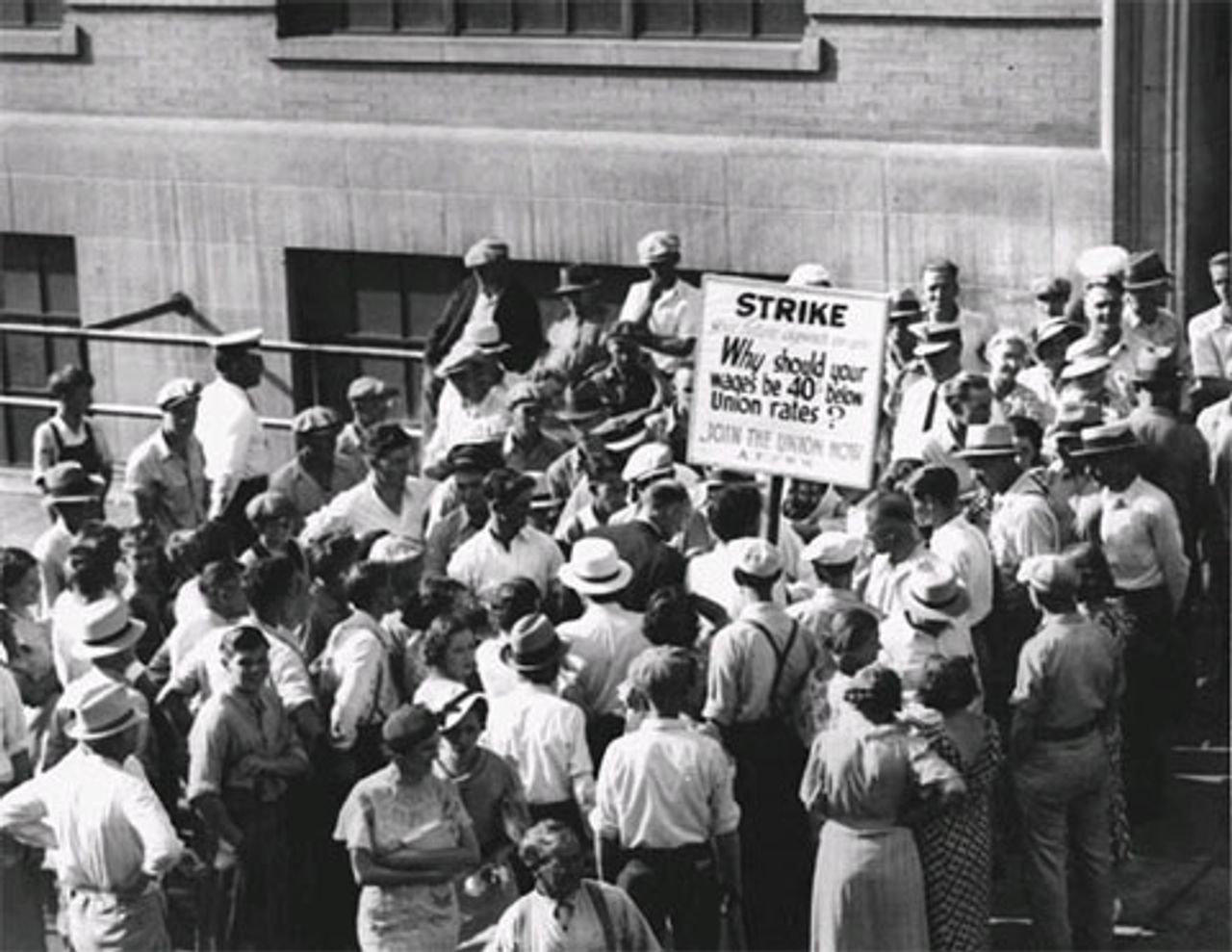 1935: Pickets and striking workers at the Strutwear Knitting Company, Minneapolis.
1935: Pickets and striking workers at the Strutwear Knitting Company, Minneapolis.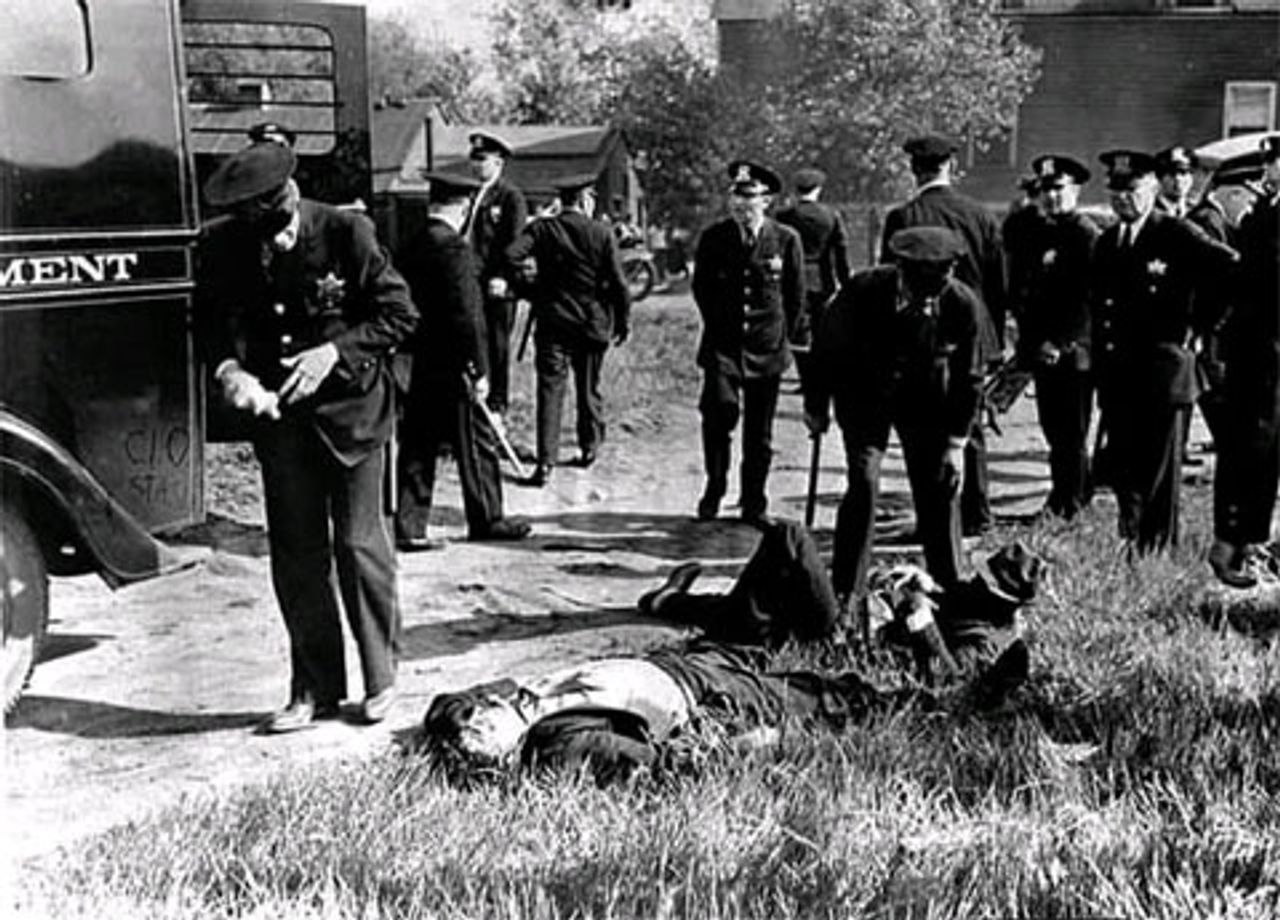 1935: Police at Strutwear Knitting Company strike, Minneapolis.
1935: Police at Strutwear Knitting Company strike, Minneapolis.The outreach of Local 574 to unions and workers sympathetic to it proved critical in the coming two years, as the American Federation of Labor (AFL) and the International Brotherhood of Teamsters (IBT) nationally, and the Minneapolis Central Labor Union and Teamsters Joint Council locally, launched a concerted effort to destroy the Trotskyist leadership of Teamsters Local 574. In April 1935, IBT President Daniel Tobin revoked the charter for Local 574 and dispatched thugs to bring the trucking membership under a new local and a leadership loyal to him.
That same year, Minnesota Farmer-Labor Party (FLP) candidate Thomas Latimer was elected mayor of Minneapolis. Latimer, however, proved to be a bitter enemy of the workers. Within one month of taking office, he joined police on the picket line to help escort scabs against a Machinists’ strike. Later, police under his command shot and killed two workers and wounded several more. In another strike, IBT Local 574 leader Vincent Dunne was seized by police, beaten, thrown into jail, and denied medical treatment for cracked ribs.
In 1936, the violence increased as Latimer, on behalf of the AFL bureaucracy and the Citizens Alliance, gave Tobin’s pistol- and blackjack-toting goons a green light to beat up Local 574 members and did nothing when they unleashed a particularly bloody attack on Vincent Dunne and Local 574 Vice President George Frosig.
But Local 574 persevered, as workers in Minneapolis and throughout the state rallied to its defense and continued organizing. Further, the local received support from a minority coalition of 15 AFL unions in the Minneapolis Central Labor Union.
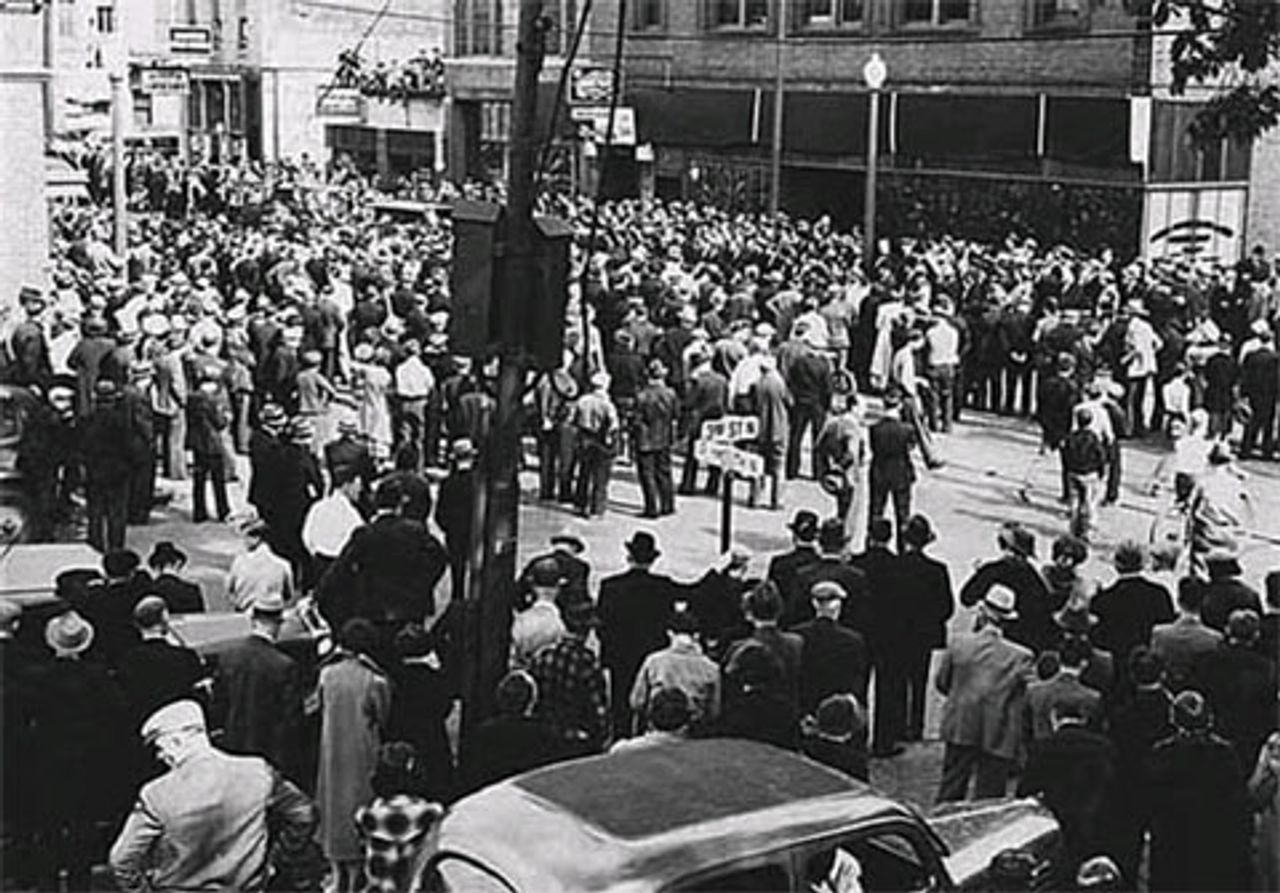 Crowd outside of meeting at Teamsters Local 544 at the corner of Third Street North and Plymouth North, Minneapolis (circa 1936).
Crowd outside of meeting at Teamsters Local 544 at the corner of Third Street North and Plymouth North, Minneapolis (circa 1936).By the end of 1936, the entire transport industry in Minneapolis was 100 percent unionized. Four of Tobin’s agents who had been sent to spearhead the destruction of Local 574 ended their goon attacks and brokered a compromise, whereby they joined forces with the Trotskyists under a new union charter, designated as Local 544. Tobin was compelled to relent for the moment, and the Northwest Organizer became the official organ of the regional Teamsters Joint Council, under the editorship of the Trotskyists. Tobin’s policy of craft unionism was replaced by industrial organization.
The surrender and defection of old-style officials might seem unusual today. And it was certainly the exception. But it was the product of careful tactics employed by the Trotskyists. Every step by Tobin’s agents was exposed in the Northwest Organizer, and workers played the decisive role in defeating the campaign against the Trotskyist leadership.
Farrell Dobbs explained that Tobin's point man in the assault “expected us to face him, staff against staff, sap against sap, gun against gun. He also assumed that the union ranks would be little more than spectators, waiting to see who would emerge the winner and proceed to lord it over them.... It didn’t take long for Murphy to become disabused of these notions.” (41)
Among the four Teamster officials who defected, L.A. Murphy, who was from the Chicago Teamsters, became a Trotskyist sympathizer. Patrick Corcoran, who led the local Teamsters Joint Council, became a critical ally of the Trotskyists in the campaign to unionize truckers throughout a six-state region of Minnesota, North and South Dakota, Iowa, Wisconsin and Upper Michigan. Corcoran’s about-face was obviously not appreciated in some circles. In 1937, gunmen murdered him late at night outside his house. The crime was never solved by the authorities.
What moved these officials was the role of the principled leadership of Trotskyism and a deep-going radicalization of the working class. Politically, on an international stage it was reflected in the development within many organizations of a left wing seeking a path to revolutionary socialism.
In 1936, the Trotskyist movement in the US entered the Socialist Party. When the conflict with the Socialist Party right wing reached its apogee in 1938, the Trotskyists emerged, having won over the left-wing elements, as the Socialist Workers Party (SWP). The same year saw the establishment of the Fourth International, to which the SWP was affiliated.
The success of the expanded organizing by the Teamsters was registered when Local 544 President Bill Brown was framed up for strike violence and faced a possible 40-year prison sentence. The Teamsters countered by threatening a strike of 20,000 truckers across four states, which led to the dismissal of charges.
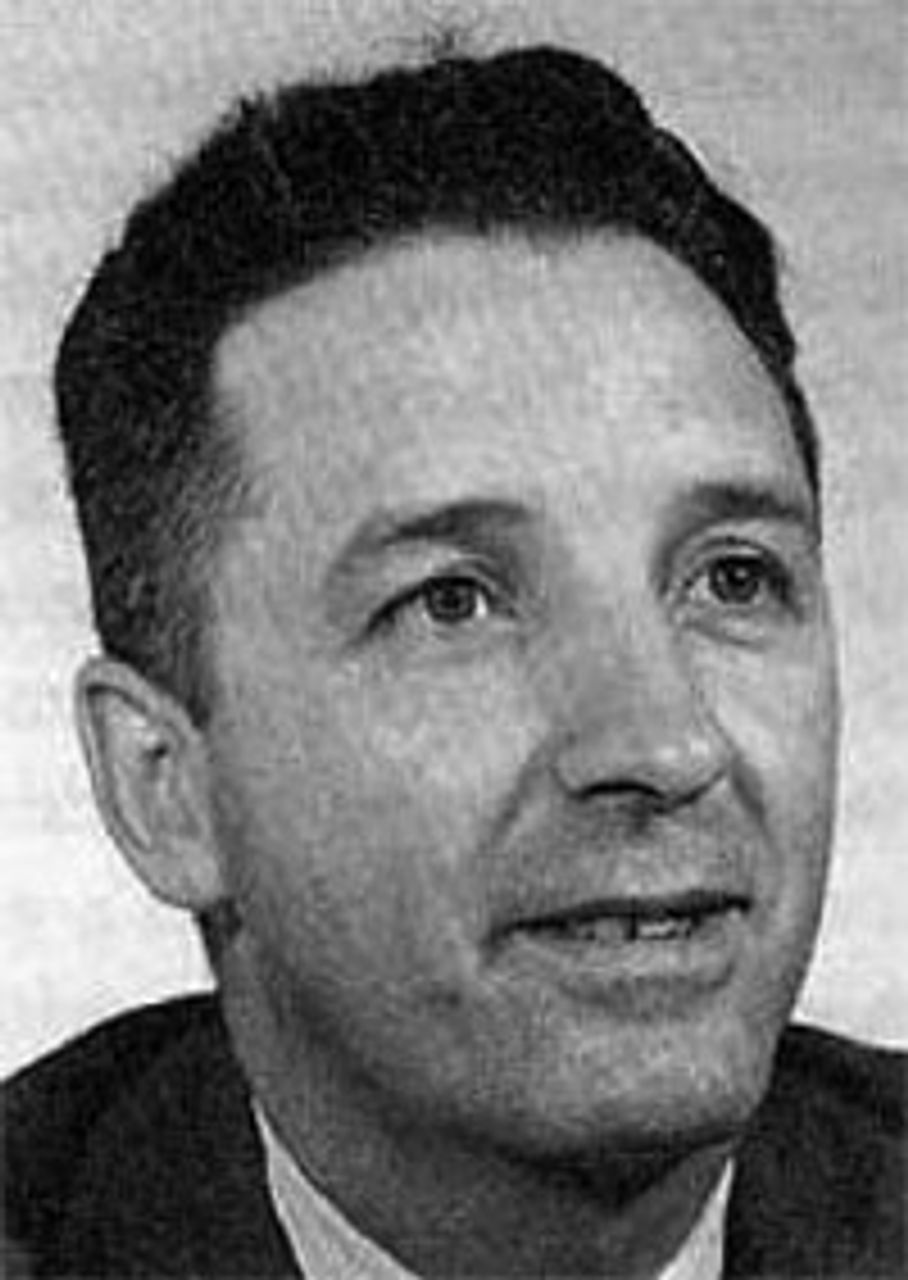 Farrell Dobbs spearheaded an
Farrell Dobbs spearheaded an 11-state campaign to organize over
the road truckers.
In 1938-1939, the over-the-road organizing campaign was extended throughout 11 states as Teamster truck drivers armed with copies of the Northwest Organizer and commanding industry-high wages of 70-75 cents an hour pulled into non-union citadels throughout the Midwest, where workers were earning as little as 30 cents an hour. The campaign ultimately registered some 200,000 members. The Teamsters, which had a membership of 80,000 in 1933, had blossomed by the fall of 1939 into an organization of 500,000 workers, due in major part to the role of the Trotskyists.
Leon Trotsky, then in exile in Mexico, took a special interest in the work of his comrades in the Teamsters. He personally met with Local 544 members to discuss the challenges facing American workers. From his pen would emerge some of the most profound analyses of the Marxist attitude to the trade unions, their limitations, and the tasks of revolutionists within them. As a result of his intervention, the Northwest Organizer became an even more pointed political tool in the work of Local 544, becoming, in Trotsky’s words, “more precise—more aggressive—more political”. (42)
In Omaha, an anti-union stronghold where some of the most violent fighting combined with labor frame-up trials took place during the 1938-1939 campaign, workers were soon reading, in addition to the Northwest Organizer, the Trotskyist newspaper Socialist Appeal, and ultimately a branch of the SWP was established.
Other significant work of the Trotskyists during this period was carried out among the unemployed and workers who labored in Roosevelt’s New Deal programs, such as the Works Progress Administration (WPA). Local 544 set up a Federal Workers Section (FWS) that organized these workers to fight for better living standards and compelled the government to pay prevailing trade union wages on federal projects. Federal workers and the unemployed were united with union workers in the struggles of that period, rather than being deployed by the corporations as strikebreakers and scabs.
The FWS met with University of Minnesota professors and students to establish new nutrition standards based on the latest scientific research. Then, through mass demonstrations, they compelled a hostile Minneapolis City council to provide higher government welfare payments to the unemployed.
Workers’ defense
In the wake of the failure of both the Citizens Alliance and the AFL bureaucracy to defeat the Trotskyists in Minneapolis, a new force emerged in the city in 1938—the Silver Shirts of America, a fascist organization modeled on Hitler’s Brown Shirts. The Trotskyists responded by initiating an organization called 544 Union Defense Guard, comprising some 600 workers who agreed to defend unions from attacks.
 Local 544’s Union Defense Guard
Local 544’s Union Defense GuardThe organization held classes to educate workers on the fascist movement and its dangers, set up an intelligence unit to monitor the Silver Shirts, gave workers training in the use of rifles and pistols, and reported its activities in the Northwest Organizer. The actions of the Union Defense Guard were subject to the control of the workers of whichever union it was called upon to defend.
It established relations with other groups, such as Jewish organizations. Emergency mobilizations, carried out to test the readiness of workers to respond to fascist attacks, unnerved the city’s ruling elite. As a coup de grâce to the Silver Shirts, the Union Defense Guard closed down one of its meetings. So thorough and demonstrative was its organization that the Silver Shirts left town. With the subsiding of the fascist threat, the 544 Union Defense Guard was demobilized.
Struggle for the political independence of the working class
The mass struggles that led to the organization of industrial unions in auto, steel, electronics, rubber, meatpacking and other industries were ultimately subordinated to the Democratic Party of Roosevelt by both the AFL and CIO bureaucracies, as well as the Stalinists of the Communist Party.
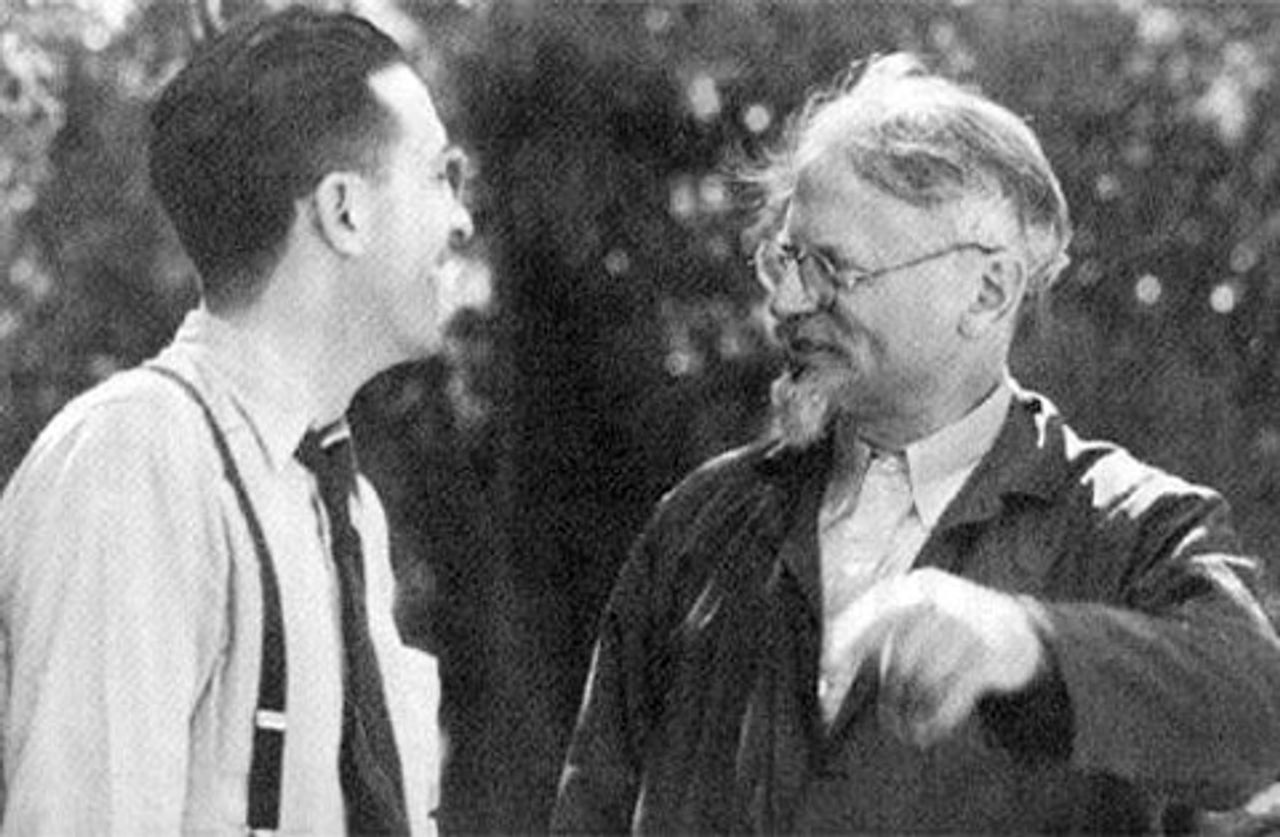 Farrell Dobbs meets with Leon Trotsky in Mexico
Farrell Dobbs meets with Leon Trotsky in MexicoThe American Trotskyists, in discussion with Trotsky himself, elaborated the demand—in opposition to the reformist union leadership and the CP—for the unions to break with the Democrats and form a labor party based on socialist policies. The aim of this tactic was to open the road to political struggle on the basis of the political independence of the working class from the capitalist parties and politicians. In Minnesota, where the reformist Farmer-Labor Party (FLP) already existed, the Trotskyists sought to bring the working class to bear as a political force within this organization.
In the FLP, the Stalinists, through fronts such as cultural and ward clubs with memberships as small as 25 people (or purely paper memberships), obtained five delegate votes, whereas Local 544, with 5,000 members, received only three voting delegates. The CP, operating under its popular front policy, fought against making the FLP a weapon of the workers. Instead, in alliance with the conservatives, including transplants from the Democratic Party, the Stalinists fought to bring the FLP under the control of Roosevelt’s Democratic Party.
The role of the right wing, combined with the strikebreaking performance of FLP Mayor Latimer, caused the party to lose credibility among workers, and the Republicans regained executive control of Minneapolis in the 1937 mayoral election. The FLP lost further ground in the 1938 gubernatorial election, when it was trounced by the Republicans, losing by more than 250,000 votes.
Among the more advanced workers, however, there still existed a strong desire to make the FLP fight on their behalf. This sentiment also existed among some union leaders, including John Boscoe of the Printers union, who led the Minneapolis Central Labor Union forces and forged an alliance with the Trotskyists of Local 544. Boscoe, while not a socialist, nevertheless wanted to enhance the power of the unions through the FLP and felt hamstrung by the Stalinist popular front policy of subordinating the FLP to the right wing.
 1937: Workers picket Minneapolis City Hall in protest against FLP Mayor Thomas E. Latimer.
1937: Workers picket Minneapolis City Hall in protest against FLP Mayor Thomas E. Latimer.In 1938-1939, the split in the FLP broke into the open as the Trotskyists launched a number of initiatives to mobilize workers for the 1939 Minneapolis mayoral elections. Dobbs writes that under the influence of Local 544, the FLP platform for the mayoral contest “represented a measurable advance over the 1936-1938 period. The labor candidates attacked the Stalinists—without red-baiting them—branding the CP a reactionary force within the workers’ movement. There was no advocacy of support to Roosevelt Democrats....” (43)
The unions defeated the Stalinists and nominated T.A. Eide, secretary of the Franklin Cooperative Creamery, as their candidate. While Eide lost to his Republican opponent, the 7,000-vote difference represented a partial recovery by the FLP from its previous debacles.
In the 1941 Minneapolis mayoral race, the labor forces again defeated the Stalinists and succeeded in nominating Eide as the FLP candidate. One of the election planks declared the party’s opposition to any involvement in an imperialist war. The volunteer campaign committees sunk deep roots in the Minneapolis working class. The election had all the earmarks of a possible victory, despite the fact that the popular front faction consisting of Stalinists and the liberals in the FLP launched a write-in campaign aimed at undermining Eide and published “lurid stories of conspiracies attributed to the Dunne brothers” who were labeled “terrorist” labor leaders. (44)
The Republicans adopted the Stalinist attacks, charging that Eide was “the candidate of the Dunnes and the underworld” and combined this with red-baiting. Tension built as the election approached its conclusion, and Eide finally broke under the anti-communist barrage.
In a debate with the Republicans, he disowned Local 544. Vote tallies on June 9, 1941, revealed that he had lost the election by 5,862 votes. The Northwest Organizer charged, “Eide’s political cowardice in the face of reaction lost him the race.” 45
World War II and the Smith Act trial
Since 1934, the Trotskyist movement and its supporters among the advanced workers had beaten back wave after wave of attacks from the Citizens Alliance, the Stalinists, the labor bureaucracy, the Democrats, the Republicans and the Farmer-Labor Party. But as the American ruling class prepared to enter the world war, it could not tolerate the existence of a leadership within any section of the working class that would not submit to class collaboration.
Since the outbreak of the war in 1939, the American Stalinists had published pacifist propaganda in opposition to war. This was in line with the foreign policy of the Kremlin, which had signed the infamous Stalin-Hitler pact on the eve of the war.
But on June 22, Hitler invaded the Soviet Union. Immediately, the American CP abandoned its pacifism and advocated US entry into the war against Germany. The FLP popular front forces now concentrated their fire on the Trotskyist leaders of Local 544 from the standpoint of patriotism and declared them “Nazi agents.”
The Trotskyist movement now remained the only consistent and socialist opponent to the march toward US entry into the war, and all the old enemies joined forces for a concerted attack. Added to this would be the full weight of Roosevelt and the federal government.
According to Dobbs, the campaign by Local 544 in Minneapolis had “put the entire AFL of the city on record against US involvement in the imperialist war.” The Northwest Organizer also editorialized against the war and was widely distributed among workers and mailed to every IBT local in the country. (46)
The Roosevelt administration began serious preparations in June 1940 to combat Trotskyism when President Roosevelt signed into law the Smith Act. The law made illegal: “Knowingly advocating the overthrow of the United States by force; knowingly helping to organize a society that engages in such advocacy or becoming a member of such a society; and conspiring with others to commit either of these offenses.” (47)
The Associated Industries (AI), a new organization of Minneapolis capitalists that replaced the Citizens Alliance, began close collaboration with the Justice Department, US military intelligence and the FBI to spy on the Socialist Workers Party, including its faction in Local 544.
Five agents were planted inside Local 544 to trigger a struggle to remove the Trotskyist influence in the union. The FBI met with IBT President Tobin on June 3, 1941, and briefed him on its surveillance of the SWP and its operations in Local 544. Tobin publicly denounced “Trotskyists” in Local 544 and declared membership in the SWP to be incompatible with membership in the IBT. He also put Local 544 into receivership, seized the local’s assets and backed the provocations of the FBI and AI agents.
Throughout the AFL and a good part of the CIO, the labor bureaucracy was tightly bound to Roosevelt and committed to supporting the drive toward war. The unions would submit to Roosevelt’s demands to impose the costs of the war on the working class. Only a small section of CIO leaders around United Mine Workers President John L. Lewis were nervous about the implications of war, as it would lead to wage cuts and undermine their control over the most militant sections of workers in coal, auto, rubber and other industrial unions.
The Trotskyist leaders of 544 now sought a national CIO charter for truck drivers as a way to mobilize the greatest number of workers against the growing reaction. While the membership of Local 544 overwhelmingly voted to switch to the new organization, 544-CIO, the Trotskyists envisioned this as a broader revolt. Several IBT locals in Minneapolis and regionally moved to follow 544-CIO.
However, D.L. Lewis, the brother of John L. Lewis and head of the new CIO organization for truckers, was incapable of carrying out broad measures quickly and decisively to encompass hundreds of thousands of workers. He would move only to recruit one local at a time, starting with 544-CIO.
As a result, Tobin, instead of facing a national uprising, was allowed to concentrate his attack on 544-CIO in Minneapolis. He dispatched 300 goons to the city to demand that workers sign pledge cards to rejoin the IBT. Workers who displayed “544-CIO” buttons on the job were pulled from their trucks or beaten up on the docks by Tobin’s forces. In cases where workers massed and fought back against Tobin’s goons, police intervened to arrest the workers.
As the battle in Minneapolis moved toward its climax, the Roosevelt administration intervened three days before union representation elections between 544-CIO and Tobin’s IBT. On June 27, 1941, the FBI raided the St. Paul-Minneapolis offices of the SWP as a preliminary to its frame-up of leading national members of the party, including James P. Cannon and the leaders of the SWP’s faction within Local 544. The government employed the Smith Act, as well as an 1861 statute originally enacted to combat the rebellion of the southern slave states.
 1941: Fourteen of the eighteen SWP members convicted under the Smith Act. Back row, left-to-right: Farrell Dobbs, Harry DeBoer, Edward Palmquist, Clarence Hamel, Emil Hansen, Oscar Coover, Jake Cooper; Front row, left-to-right: Max Geldman, Felix Marrow, Albert Goldman, James Cannon, Vincent Dunne, Carl Skoglund, Grace Carlson.
1941: Fourteen of the eighteen SWP members convicted under the Smith Act. Back row, left-to-right: Farrell Dobbs, Harry DeBoer, Edward Palmquist, Clarence Hamel, Emil Hansen, Oscar Coover, Jake Cooper; Front row, left-to-right: Max Geldman, Felix Marrow, Albert Goldman, James Cannon, Vincent Dunne, Carl Skoglund, Grace Carlson.From October to December, members of the SWP were put on trial in a Minneapolis courtroom. As David North explains in The Heritage We Defend, Cannon denied the government’s charges, “which threatened the illegalization of the Socialist Workers Party...upheld the party’s opposition to the imperialist war and defended the program for socialist revolution.” Eighteen members of the SWP were found guilty and sentenced to prison terms of up to a year and a half. (48)
During and after the trial, the SWP mounted a powerful campaign to both defend the 18 frame-up victims and educate the working class in the principles of Marxism. Cannon’s testimony in the trial was published and played a central role in this endeavor.
The Minneapolis trial represented the only use of the Smith Act before or during World War II. The frame-ups and imprisonment removed the Trotskyists from the leadership of the truckers.
The Stalinists, who had cheered on Roosevelt’s prosecution of the Trotskyists, would later, with the advent of the Cold War, come under attack by the Truman administration and see their members imprisoned and hounded out of their jobs, as the American ruling class and the labor bureaucracy waged a campaign to extirpate all vestiges of opposition in the working class to capitalism.
As part of the Cold War witch-hunt, the Stalinists were ejected from the Farmer-Labor Party and a faction of anti-communists led by Hubert H. Humphrey merged the FLP with the Democratic Party to form the Minnesota Democratic Farmer-Labor Party, thereby bringing this entity firmly under ruling class control.
***
In the events of the Minneapolis truckers’ strike of 1934, the working class demonstrated its revolutionary potential. But the high level of class-consciousness evinced in the struggle—which ultimately led to victory—was due above all to the role of revolutionary leadership.
The crisis of the capitalist system today will again bring forth the revolutionary potential of the working class—but with a difference. The America of today does not have the economic reserves of the America of Roosevelt’s time, which provided the basis for Roosevelt to implement a reformist policy. The only road ahead is that of struggle for the international unity of the working class and socialism. The lessons of 1934 and those of the entire history of the Trotskyist movement internationally must be assimilated to prepare the leadership of the struggles to come.
Footnotes
40. Art Preis, Labor’s Giant Step: Twenty Years of the CIO (Pioneer Publishers, 1964), p. 41-42.
41. Farrell Dobbs, Teamster Power (Anchor Foundation, Inc., 1973), p. 115.
42. David North, The Heritage We Defend: A Contribution to the History of the Fourth International (Labor Publications, 1985), p. 39.
43. Farrell Dobbs, Teamster Politics (Anchor Foundation, Inc., 1975), p. 172.
44. John Earl Haynes, Dubious Alliance: The Making of Minnesota’s DFL Party (University of Minnesota, 1984), p. 80.
45. Farrell Dobbs, Teamster Politics, p. 172.
46. Farrell Dobbs, Teamster Bureaucracy (Anchor Foundation, Inc., 1977), p. 113.
47. Millikan, p. 338.
48. North, p. 55, 56.
